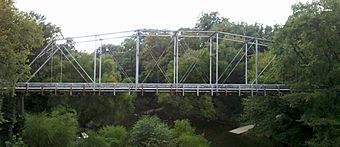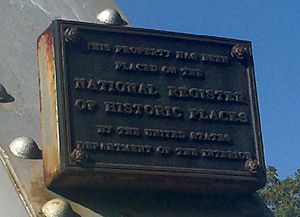Deep River Camelback Truss Bridge facts for kids
The Deep River Camelback Truss Bridge is a special kind of bridge. It's made of strong steel and sits on sturdy stone and concrete supports. The road on the bridge is made of wooden planks covered with a material called macadam.
This bridge crosses the Deep River in North Carolina, USA. It connects two small communities, Gulf and Cumnock. The bridge is surrounded by peaceful woods and farms. It was built a long time ago, around 1901.
This bridge is so important that it's listed on the National Register of Historic Places. This means it's a special historical landmark. Today, only people walking can use this old bridge. Cars and trucks use a newer bridge located nearby.
Exploring the Bridge's Location
The Deep River Camelback Truss Bridge is found inside Deep River Park. This park is a great place for families, with picnic areas and a boat ramp for launching boats. It's also a popular spot for a fun outdoor game called geocaching!
To visit the bridge, you can start from US-421 near the Deep River. Head southeast and turn left onto Cumnock Road. Follow this road until you reach the county line. When you cross the river on the new bridge, look to your left to see the historic truss bridge. Continue a short distance north to Everett Dowdy Road, and you'll find the park entrance on your left.
The Bridge's Amazing History
The Deep River Camelback Truss Bridge is also known as Truss Bridge #155. It helps people travel between the communities of Cumnock and Gulf. For many years, this area near the Deep River was busy with mining for coal, iron, and copper. There were also factories that made things from iron.
This bridge has an interesting past! It was first built in 1901 as part of a much longer bridge. That original bridge was over the Cape Fear River, about 30 miles away. In December 1930, a part of that big bridge fell down. So, in 1932, one of the good sections was carefully moved and rebuilt here over the Deep River. It replaced an old wooden bridge that had burned down a few years earlier, around 1929.
People have been crossing the river at this spot for a very long time, since at least 1833. One of the stone supports for the bridge on the north side might even be from a much older bridge. That older bridge was called Evans Bridge.
In 1979, experts recognized this bridge as a great example of how metal bridges were built between 1880 and 1935. It showed how transportation was improving in North Carolina during that time. Today, Truss Bridge #155 is one of only four camelback truss bridges left in North Carolina. That makes it very special and important to preserve!
In 1992, a new concrete bridge was built nearby for cars and trucks. The older, historic bridge was then given to the Deep River Park Association. This group is working to keep the bridge safe and use it as part of a walking and biking trail they are developing.
How the Bridge is Built
Truss Bridge #155 is a "camelback" truss bridge. It is 160 feet long and divided into eight sections, called panels. The two main truss structures are connected by a system of strong metal bars. These bars help make the bridge very stable and prevent it from swaying.
The parts of the truss system are joined together with large pins, like giant hinges. The bottom parts of the trusses have special holes, and other parts have strong, welded connections. The bridge rests on sturdy supports made of rough stone on the north side and concrete on the south side. The road surface is made of wooden planks covered with macadam. If you look closely below the bridge, you might even see the remains of an older bridge's supports!






